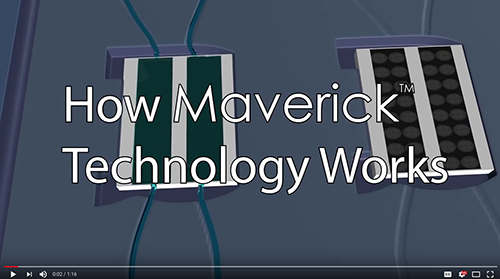Genalyte’s cloud-based Maverick Detection System could potentially change how and when doctors order blood draws, altering long-standing clinical laboratory workflows
Anatomic pathologists and medical laboratory leaders may be aware of efforts in the in vitro diagnostics (IVD) industry to perform clinical laboratory tests with smaller quantities of blood. The most high-profile company to try and fail is Theranos, which both Dark Daily and its sister print publication The Dark Report reported on as events unfolded.
So far, though, continued efforts to dramatically reduce the amount of blood needed for most typical medical laboratory tests have come up dry. But this has not stopped innovative companies from trying to do so.
One such company is San Diego-based Genalyte. The biomedical diagnostics developer has announced it is readying its new Maverick Detection System (Maverick), which, according to the company’s website, “completes a comprehensive battery of blood tests in the physician’s office with results in 15 minutes.”
According to a news release, “Genalyte is laying the groundwork to move the business of biomedical diagnostics online, with the idea of creating an integrated delivery service for test results that can be generated from a drop of blood.” If successful, Maverick may be poised to disrupt the phlebotomy and clinical laboratory industries in a big way.
Fifteen Minutes from Fingerprick to Clinical Lab Test Results
Maverick, according to its developers, “[will] send digital samples to the cloud for quality review before releasing to the physician and patient. Our central lab handles tests that cannot be completed onsite.
“At the core of our cloud-based, diagnostic laboratory offering is revolutionary technology that uses silicon photonic biosensors to perform multiple tests off a single drop of whole blood in 15 minutes,” notes Genalyte’s website.
In a MedCity News article, Cary Gunn, Genalyte’s founder and CEO, said, “There will always be a need for esoteric testing that needs to be referred to a laboratory. But for the vast majority of routine testing, there’s no reason why that can’t be done in the doctor’s office.”
How Maverick Completes Medical Laboratory Tests in Doctor’s Offices
According to Genalyte’s website, “The Maverick Detection System performs real-time detection of macromolecules in crude samples using biologically functionalized silicon photonic biosensors lithographically printed on disposable silicon chips.”
About the width of a pencil erasure, Maverick biosensor chips “are individually functionalized with unique probe molecules and are individually interrogated, making highly multiplexed analysis possible. As a sample flows over the chip, the probes on the sensors bind with their corresponding ligands. This binding results in a localized change in refractive index on the sensor surface; this change is directly proportional to analyte concentration.”
“The silicon chip itself is watching the chemical reactions take place. Anytime two molecules bind, we can see that happen. So, the technology is capable of almost an infinite number of tests,” Gunn explained in the MedCity News article.
According to the developer, test results are available “in 10-30 minutes depending on the type of assay performed.”

Cary Gunn, PhD, Genalyte’s Founder and Chief Executive Officer, said in a news release that the San Diego-based biomedical diagnostics company wants “to put a rapid and powerful suite of diagnostic tests in every physician’s office.” (Photo copyright: Genalyte.)
Pilot Studies Show Test Feasibility in Doctor’s Offices
The company also announced completion of two pilot studies of the platform’s effectiveness in performing anti-nuclear antibody (ANA) testing. The purpose of study “one” was to “evaluate the feasibility of using this novel instrument to perform ANA 8 tests in the clinic and to compare those results to the same sample tested in Genalyte’s CLIA registered laboratory.” Study “two” focused on “Detection of anti-nuclear antibodies for the diagnosis of connective tissue diseases (CTD).”
The ANA test is often ordered by physicians for diagnosis of CTDs, including:
• Rheumatoid arthritis;
• Systemic lupus erythematosus;
• Raynaud syndrome; and,
• Systemic scleroderma, according to an article in Rheumatoid Arthritis News.
“We are starting with rheumatology, but I call that our entry point,” Gunn told MedCity News. “Our goal is to decentralize the vast majority of diagnostic testing to be near the patient and near the physician.”
The two studies together involved about 750 patients, who were tested by Genaltye’s Maverick system over four months. Results of their blood tests, via fingerprick in the doctor’s office, were compared to traditional medical laboratory procedures and patient diagnoses.

According to the Genalyte video above, “The Maverick Detection System … directly detects the binding of proteins or antibodies to the sensor in real-time and results are analyzed simultaneously with the accompanying Genalyte software. Almost all of the most time consuming and expensive parts of assay development and sample testing are reduced or eliminated.” Click on the image to view the video. (Caption and video copyright: Genalyte.)
According to the news release and the published clinical abstracts, the researchers concluded that:
• Positive and negative results on whole blood tested on the Maverick system highly correlated with serum tested on previously approved devices;
• Multiplex ANA testing on whole blood in physician offices is feasible;
• Venous draw and fingerstick blood samples highly correlated; and
• Maverick has the propensity to improve patients wait times for diagnosis and to enhance their testing convenience.
“There is extremely high correlation for absolute value between venous blood and fingerstick blood, and between positive and negative results seen with whole blood on the Maverick and serum on the FIDIS Connective 10,” noted study “one” researchers.
“I’m impressed,” Patricia Jones, PhD, former President of the American Association for Clinical Chemistry (AACC), told Bloomberg News. “The game-changing part of this would be being able to do testing and potentially make a diagnosis immediately, instead of having to send out lab tests, wait several days, and then call the patient,” she added.
Can One Drop Do It All? Some Researchers Advise Caution
The controversy surrounding point-of-care fingerprick capillary blood draws performed on in-office automated blood analyzers, versus clinical laboratory venous draws performed on high-volume laboratory systems, is not new. Dark Daily has reported on several blood test studies in the past.
One such study involved bioengineers at Rice University. It concluded that fingerpricked capillary blood may not be accurate or reliable enough for clinical decision-making.
Their study acknowledged the value of such capillary blood testing in remote areas. But it also urged caution about use of measurements from a single drop of fingerprick blood.
“Using both a hematology analyzer and POC hemoglobinometer, we found the variability of blood component measures to be greater for successive drops of fingerprick blood than for multiple drops of venous blood,” the researchers wrote in The American Journal of Clinical Pathology (AJCP).
Research will no doubt continue until a viable, accurate, and affordable blood analyzer system that conducts dozens of clinical laboratory tests based on a few drops of blood comes to market. It’s basically inevitable in today’s world where computers can be built from molecules and miniature medical laboratories can be placed in chips, skin patches, and needles.
Pathologists and clinical laboratory leaders would be well advised to monitor the development of these various new diagnostic technologies. For most of the past decade, there has been a steady parade of companies and research teams announcing new discoveries that could revolutionize clinical diagnostics as performed today. However, few disruptive clinical laboratory tests or analyzers based on these technologies have made it into the clinical marketplace.
—Donna Marie Pocius
Related Information:
Can Genalyte Achieve What Theranos Touted?
Genalyte Takes Aim at Lab Testing Giants with Cloud-Based Service
Genalyte Raises $36 Million From Khosla for its One-Drop Blood Test
AACC President Calls Genalyte’s Blood Diagnostic Tests ‘Game-Changing’
Genalyte Diagnostic Tool Shows Potential to Improve Turnaround Time in RA, Other Conditions



